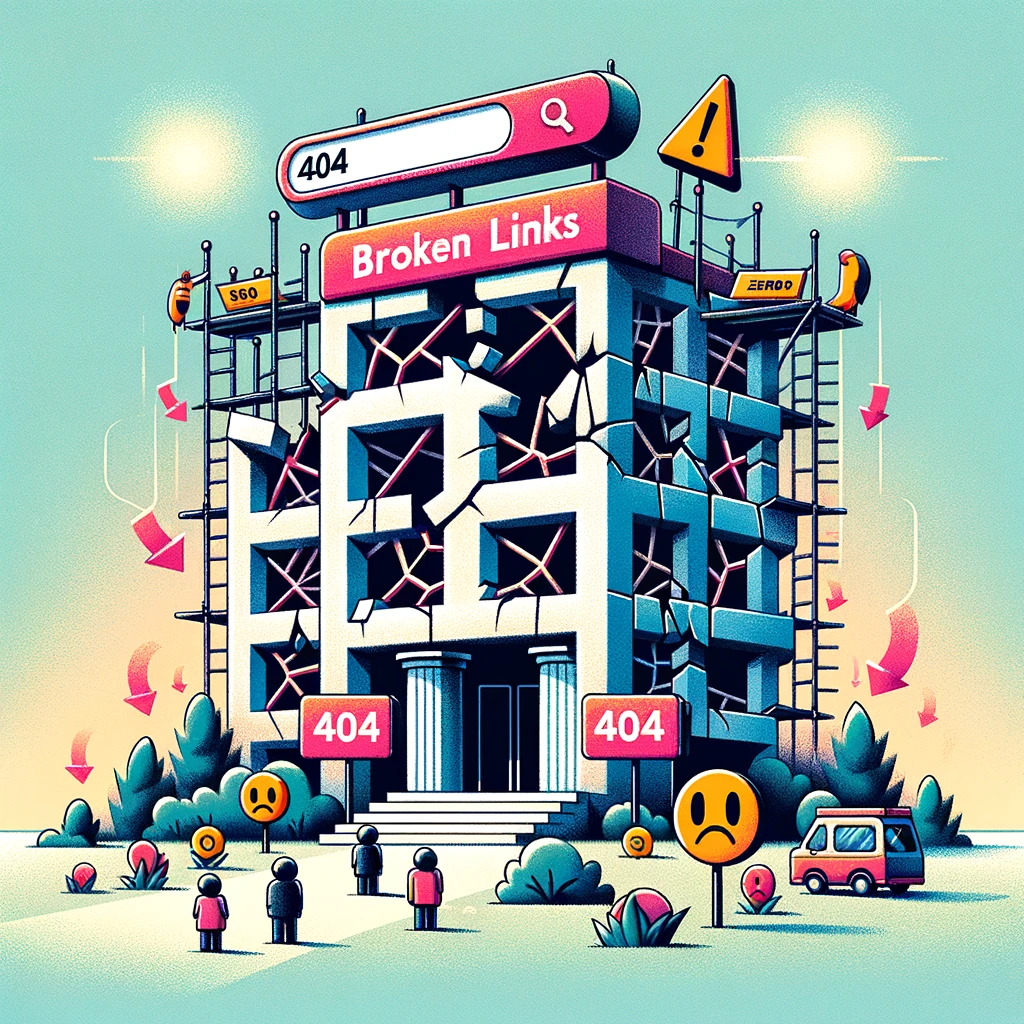
Why are broken links bad?
Broken links refer to hyperlinks on a website that no longer lead to the intended destination or are non-functional. When users click on such links, they encounter error messages instead of the expected content. Broken links can negatively impact user experience, hinder search engine rankings, and make it challenging for both visitors and search engines to navigate a website effectively. Regularly checking and fixing broken links is essential for maintaining a seamless online experience.
Broken links are considered bad for several reasons:
User Experience (UX):
When a visitor clicks on a link and encounters a "404 Not Found" or similar error message, it disrupts their browsing experience. This can be frustrating for users who are trying to access specific content, and it may lead them to leave the website.
Broken links negatively impact users in the following ways:
-
Frustration: Users become frustrated when they click on a link expecting specific content, only to find that the link is broken. This can lead to a negative perception of the website.
-
Confusion: Broken links can confuse users, especially if there is no clear indication of what went wrong or how to find the intended content.
-
Disappointment: Users may feel disappointed if they are unable to access content they were interested in due to a broken link.
-
Time Wasting: Users waste time trying to access content through broken links, which can be particularly aggravating if they are in a hurry or searching for important information.
-
Navigation Disruption: Broken links disrupt the smooth navigation of a website, making it harder for users to find what they need and move between pages seamlessly.
-
Decreased Engagement: Users are less likely to engage with a website if they encounter broken links, as it can be a sign of neglect or poor quality.
-
Loss of Confidence: Repeated encounters with broken links can lead users to lose confidence in the reliability and professionalism of the website.
Addressing broken links promptly is crucial for maintaining a positive user experience and keeping visitors engaged and satisfied with the website.
SEO (Search Engine Optimization):
Search engines like Google use algorithms to rank websites based on various factors, including the quality and relevance of their content. Broken links can negatively impact a website's SEO because search engines may interpret them as a sign of poor maintenance or outdated content. This can result in lower search engine rankings, making it harder for users to discover the site through search queries.
For SEO , broken links can have several negative impacts:
-
Crawl Errors: Search engines like Google use bots to crawl and index websites. Broken links can cause crawl errors, preventing bots from indexing pages effectively.
-
Lower Rankings: Search engines consider the quality and usability of a website when determining rankings. A site with many broken links may be perceived as poorly maintained, leading to lower rankings in search results.
-
Reduced Link Equity: Links are a way of passing value (link equity) between pages. Broken links interrupt this flow, potentially reducing the overall link equity of a website.
-
User Engagement Metrics: Search engines use user engagement metrics (such as bounce rate and time on site) as ranking signals. Broken links can lead to higher bounce rates and lower time on site, negatively impacting rankings.
-
Lost Backlink Value: If external websites link to a page on your site that becomes broken, the value of those backlinks is lost, which can negatively impact your site's authority and rankings.
-
Sitemap Issues: Broken links in a sitemap can lead to indexing issues, as search engines rely on sitemaps for a clear structure of the website.
-
Negative User Experience: While this is also a user experience issue, search engines take user experience into account for SEO. A poor user experience due to broken links can indirectly affect SEO.
Regularly monitoring and fixing broken links is essential for maintaining a healthy website that performs well in search engine rankings.
Trust and Credibility:
A website with broken links may appear outdated, neglected, or poorly maintained. Users are less likely to trust a website that doesn't provide a seamless browsing experience, and this lack of trust can affect the site's credibility.
Broken links can significantly impact trust and credibility in the following ways:
-
Perceived Neglect: A website with numerous broken links may appear neglected or abandoned, leading users to question the reliability and professionalism of the site or the organization behind it.
-
Damaged Reputation: Consistent encounters with broken links can damage a website's reputation. Users may view the site as unreliable or of low quality, which can be particularly detrimental for businesses or organizations that rely on their online presence.
-
Loss of Authority: For websites that aim to be authoritative sources of information, broken links can undermine their credibility. Users may doubt the accuracy and relevance of the content if links that are supposed to provide additional information or sources are broken.
-
Decreased User Trust: User trust is crucial for online interactions, especially for e-commerce or service-oriented websites. Broken links can erode this trust, making users hesitant to engage with the site, such as making a purchase or providing personal information.
-
Impaired Brand Image: For brands, broken links can tarnish their image and give an impression of carelessness or lack of attention to detail.
-
Reduced Customer Confidence: In the context of online shopping or services, broken links can reduce customer confidence in the transaction process, leading to abandoned carts or reluctance to return to the site.
-
Competitive Disadvantage: In competitive markets, websites with fewer broken links may be perceived as more reliable and credible, putting those with broken links at a disadvantage.
Addressing broken links promptly is essential for maintaining trust and credibility with users and ensuring a positive perception of the website and the organization it represents.
Accessibility:
Broken links can create accessibility issues, especially for users with disabilities who rely on screen readers or other assistive technologies. Inaccessible content can prevent certain users from fully engaging with the website.
Broken links can also negatively impact accessibility in several ways:
-
Barrier to Information: For users with disabilities who rely on assistive technologies, broken links can create barriers to accessing information. This can be especially frustrating if the user has navigated through multiple pages only to encounter a dead end.
-
Navigation Challenges: Users who rely on screen readers or keyboard navigation may find it more difficult to navigate a website with broken links. This can disrupt their experience and make it harder to find the content they need.
-
Increased Effort: Users with cognitive or motor impairments may have to expend extra effort to find alternative routes to the desired content, leading to a more exhausting and less accessible experience.
-
Loss of Context: Broken links can lead to a loss of context, especially for users who rely on the link text to understand the purpose of the link. Without a functioning link, the context may be lost, making it harder for users to comprehend the content.
-
Reduced Independence: For users who value their independence in navigating the web, broken links can be a significant hindrance, forcing them to seek assistance more frequently.
-
Compliance Issues: Websites that are required to comply with accessibility standards, such as the Web Content Accessibility Guidelines (WCAG), may face compliance issues if broken links are present, as these can be considered a failure to provide accessible navigation.
Addressing broken links is important not only for general usability but also for ensuring that the website is accessible to all users, including those with disabilities.
Analytics and Metrics:
Broken links can distort website analytics and metrics. If users are unable to access specific pages due to broken links, it may affect data related to user engagement, conversion rates, and other important metrics.
Broken links can also impact analytics and metrics in several ways:
-
Skewed Data: Broken links can lead to inaccurate analytics data. For example, a high bounce rate on a page might be due to a broken link rather than uninteresting content.
-
Misleading User Behavior Insights: Broken links can distort the understanding of user behavior. For instance, if users leave the site after encountering a broken link, it might be interpreted as disinterest in the content rather than frustration with a broken link.
-
Impacted Conversion Tracking: For websites with conversion goals, broken links can disrupt the conversion funnel, leading to inaccurate tracking of conversions and attribution.
-
Decreased Engagement Metrics: Broken links can lead to decreased engagement metrics, such as time on site and pages per session, as users may leave the site prematurely.
-
Difficulty in Identifying Problem Areas: Broken links can make it challenging to identify areas of the website that need improvement. For example, a page with a high exit rate might be due to a broken link rather than the content itself.
-
Inaccurate Referral Data: Broken links can also affect referral data, as they may prevent the accurate tracking of where traffic is coming from or going to.
-
Impact on A/B Testing: For websites conducting A/B testing, broken links can skew the results, leading to inaccurate conclusions about the effectiveness of different versions of a webpage.
Addressing broken links is important for maintaining the integrity of analytics and metrics, which are crucial for making informed decisions about website improvements and marketing strategies.
To maintain a positive user experience, enhance SEO, and establish trust and credibility, it's crucial for website owners and administrators to regularly check for and fix broken links on their websites. Automated tools and manual checks can be used to identify and address broken links efficiently.
see:
- How to detect broken links?
- How fix broken links?
- What are the risks of website migration and how to make the migration secure?
- Why is it necessary to conduct a website audit?
- Why Choose IssueDetector Broken Link Checker?
